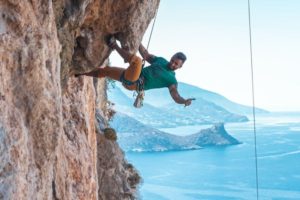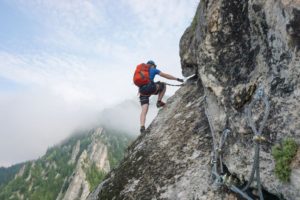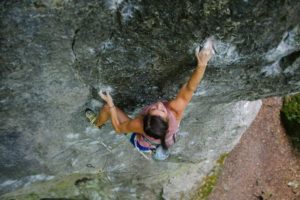Self-belaying is a crucial skill for climbers who want to train alone or improve their skills without a partner.
Using a Grigri as a self-belay device is a popular choice for many climbers due to its reliability and ease of use.

However, proper knowledge and precautions are necessary to ensure safety.
We will provide a comprehensive guide and cover the mechanics of self-belaying, safety considerations, advantages, and disadvantages, and many more.
By the end of this article, you will have a better understanding of how to safely and effectively self-belay with a Grigri.
Using a Grigri for Self-Belaying
Using a Grigri for self-belaying involves setting up the device correctly and understanding the mechanics of how it functions.
Understanding the Mechanics
It is essential to understand how the device’s camming mechanism works.
The Grigri uses a spring-loaded cam that rotates to pinch the rope when weight is applied to it.
When climbing, it is attached to an anchor point, and the rope is fed through it.
As the climber ascends, the rope is pulled up through the device, causing the cam to rotate and pinch the rope.
In case of a fall, the camming mechanism automatically locks onto the rope, arresting the fall and holding the climber in place.
Proper body positioning and technique are crucial to ensure it functions correctly during self-belaying.
Setting Up
Find a Suitable Anchor Point
Look for a secure anchor point, such as a bolt or a sturdy tree, to attach it.
Attach It to the Anchor Point
Clip it to the anchor point using a locking carabiner.
Thread the Rope through It
Ensure the rope is threaded through it in the correct direction according to the manufacturer’s instructions.
Tie a Backup Knot
Tie a backup knot such as a figure-eight or a stopper knot, a few feet above the Grigri. This will act as a safety backup in case it fails.
Attach Yourself
Attach yourself to it using a locking carabiner and a climbing harness.
Test the System
Before climbing, conduct a thorough safety check to ensure that it is correctly set up and functioning correctly.
Test it by applying weight to the rope and ensuring the camming mechanism engages correctly.
Begin Climbing

Once you are confident in its functionality, you can begin climbing.
Make sure you maintain proper body positioning and technique to ensure that it functions correctly.
NOTE
These steps are a general guide and climbers should always follow the manufacturer’s instructions and recommendations for their specific Grigri model.
Tips for Using
- Practice using it as a belay device with a partner before attempting to self-belay.
- Always double-check that it is set up correctly and functioning correctly before climbing.
- Never let go of the rope when climbing, as this can cause it to malfunction.
- Keep the rope free from tangles and knots to ensure its smooth operation.
- Use a dynamic rope with a suitable diameter for it to ensure optimal performance.
- Be aware of the weight difference between climbers and adjust the tension accordingly.
- Always tie a backup knot a few feet above the Grigri as an additional safety measure.
Safety Considerations
When it comes to self-belaying, safety is paramount.
There are several safety considerations that climbers need to be aware of before attempting to self-belay.
In this section, we will discuss some of the most important safety considerations during the climb.
By following these safety considerations, climbers can minimize the risk of injury or accidents.
Importance of Safety Checks and Proper Usage of Equipment
Performing safety checks and using equipment correctly is crucial to ensuring safe self-belaying.
Not taking this action could lead to severe harm or even fatality.
Climbers must inspect their gear before each climb and follow the manufacturer’s instructions for proper usage.
Ensuring that the Grigri works effectively during the climb also requires climbers to maintain the correct body position.
In addition, climbers should be aware of their own limitations and the limitations of their equipment and avoid taking unnecessary risks.
Common Mistakes to Avoid
- Using it upside down or threading the rope incorrectly.
- Using it with a rope that is too thin or too thick for the device.
- Letting go of the rope or not keeping a hand on the brake side of the rope while climbing.
- Using a worn or damaged rope or equipment.
- Failing to maintain proper body positioning and technique while climbing.
- Neglecting to perform safety checks before climbing or assuming it is set up correctly without testing it first.
- Climbing without proper training or experience.
Advantages and Disadvantages
Self-belaying with a Grigri has both advantages and disadvantages for climbers.
It provides increased safety and control during climbs, allowing climbers to practice and improve their skills in a controlled environment.
On the other hand, it also creates a false sense of security and leads to complacency, which can be dangerous.
Advantages
Increased Safety
It can provide an extra level of safety for climbers, especially when practicing more challenging routes or movements.
Control
It allows climbers to control the rope and descent speed with one hand, which can make it easier to focus on technique and body positioning.
Practice
It can provide a controlled environment for climbers to practice new skills or movements without the risk of a fall.
Independence
It can allow climbers to climb alone or with a partner without the need for a belayer.
Efficiency

Using it can be more efficient than traditional belaying methods, as it requires less physical effort and can save time during climbs.
Disadvantages
False Sense of Security
Self-belaying can create a false sense of security, leading climbers to take risks they might not take with a belayer.
Complacency
A false sense of security can also lead to complacency, which can be dangerous in climbing.
Lack of Feedback
Climbers may not receive the same feedback or guidance from a belayer, which can be detrimental to their learning and progress.
Increased Risk of Accidents
If not used properly or with proper training, it can lead to accidents, such as dropping the device or improper rope management.
Limited Usefulness
It may not be suitable for all types of climbing, such as multi-pitch or alpine climbs, where a belayer may be necessary.
NOTE
Climbers should consider the advantages and disadvantages and only attempt it with proper training, experience, and a thorough understanding of the risks involved.
Importance of Continued Learning and Practice
Continued learning and practice are essential for climbers.
Climbing is a constantly evolving sport, and new techniques, equipment, and safety considerations are always emerging.
By staying up-to-date with the latest information, and regularly practicing safe self-belaying techniques, climbers can minimize the risks and maximize the benefits of using a Grigri for self-belaying.
It is also important to seek guidance from experienced climbers, instructors, and guides, and to never stop learning and growing as a climber.
Takeaway
Self-belaying with a Grigri can be a useful and rewarding technique for climbers looking to improve their skills and practice new techniques.
However, climbers must always prioritize safety, regularly check their equipment, and be aware of the limitations and potential drawbacks.
By following safety guidelines, you can use a Grigri as a self-belay device to enhance your climbing experience.

I was working as a mountain guide, probably all around the planet. One day, I met my wife in the mountains, literally on top of the world. Now, I have a beautiful family and three kids, so I don’t have much time for climbing, but sometimes I go camping with my friends. I am also into gym workouts, and I can’t imagine my life without sports.
Since I ended my professional career as a climbing guide, I’ve been giving personal classes and helping amateurs to get ready for conquering their first peaks. Also, that’s how the whole blog idea appeared.





